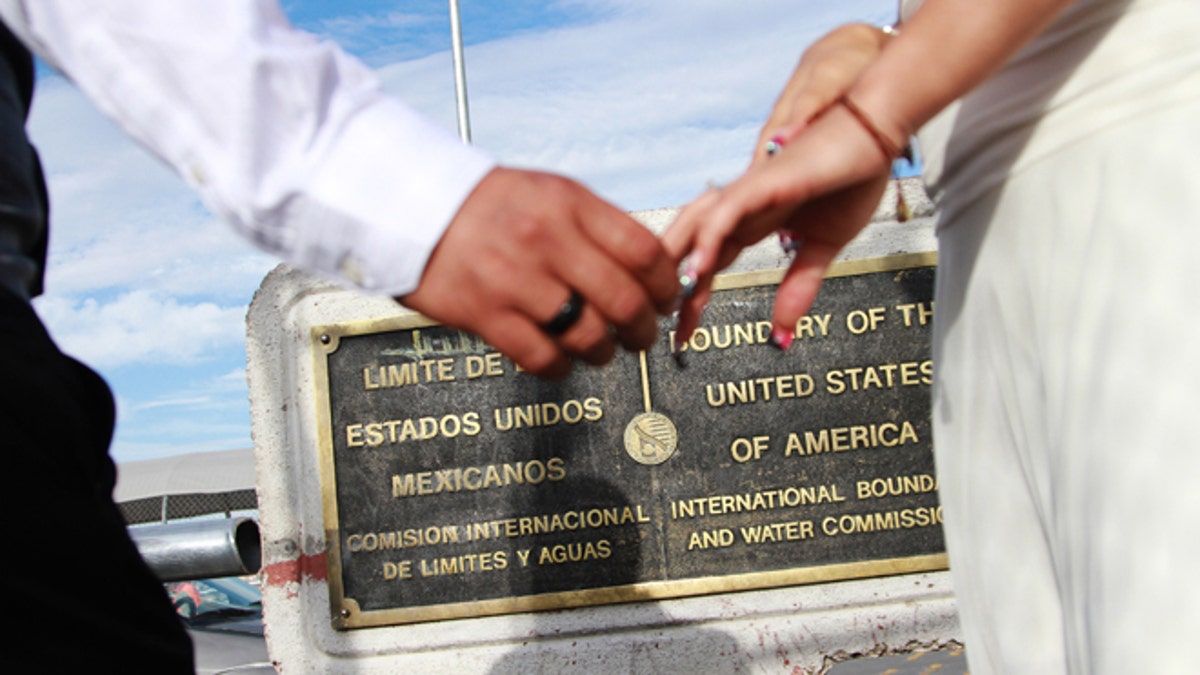
U.S. citizen Edgar Falcon, left, and Maricruz Valtierra of Mexico, hold hands at the U.S.-Mexico border where they were married, Tuesday, Aug. 27, 2013 in El Paso, Texas. Like many other couples made up of a US citizen and a foreigner, Falcon and Valtierra, who has been declared inadmissible after an immigration law violation, hope immigration reform will help them live together in the U.S. (AP Photo/Juan Carlos Llorca) (ap)
I'm a Catholic Latino, you know the type who's often described by politicians as a group they need to court or even admire because "we're very pro family." Patronizing nature of the assertion aside, it is generally accurate. I say generally because when it comes to these types of descriptions, there is no such thing as one size fits all, but we'll take it. As for me, yes it fits. I've married only once, to a woman I plan to be with until one of us passes on. We live in the suburbs where we are raising four kids. On weekends, we visit my parents or my brothers and very much consider ourselves "traditional," whatever that means.
Speaking anthropologically, we've progressed and succeeded as a society by creating orderly relationships which are centered around a monogamous relationship.
I express all of the above not to impress, but rather as an explainer to those of you, especially in the media, who find it difficult to understand us "Neanderthals" who bristle at the thought of constantly having to accept new lifestyles. The newest media push is, I guess, polyamorous relationships, which I've now witnessed being depicted on several specials and news reports as a reasonable alternative to traditional marriage. ABC news, for example, asks us to "have an open mind" and consider whether "they have a point."
So what is the point of polyamory? It's essentially about loving not one person, but two, three, maybe four or five at once. Here, let me explain it as it was explained to me on the ABC News report. A man shares his bed with his wife and her girlfriend, who may also share it with her boyfriend and his boyfriend. I could go on, but I think you get the picture?
As for kids? They'll be fine, after all, "it takes a village" right? Yep, that's what polyamors say they believe. And many of them, including some of their supporters in the media, tend to look at us traditionalists as troglodytes, you know "Neanderthals."
But guess what, Professor Dean Snow of Penn State University says "the difference between being pair-bonded and non pair-bonded mating is a major watershed within primates. If a distinction is that Neanderthals weren't pair-bonded and modern humans were, that would be a major consideration in trying to figure out why modern humans out-competed Neanderthals in Europe." Hmmm!
And why does he say that? Because a study by Emma Nelson of the University of Liverpool and team of researchers who combed through the literature on early humanlike primates found that Neanderthals were likely a promiscuous bunch who, like many primates alive today, probably lived in groups. Males may have likely either kept harems of female mates, or males and females each mated with multiple partners.
In other words, speaking anthropologically, we've progressed and succeeded as a society by creating orderly relationships which are centered around a monogamous relationship. Again I say, hmmm!
I present this research not to deny that I am in many ways a certain and admitted troglodyte, but rather to assert what few dare ask — which is, "Who is the real Neanderthal?"
